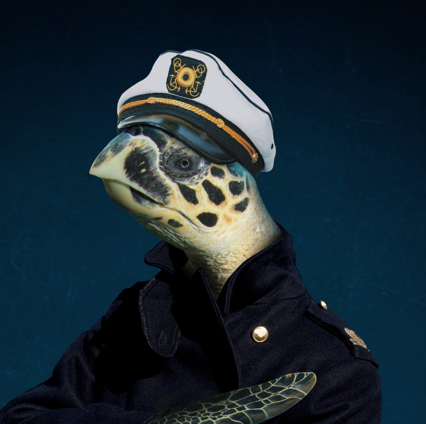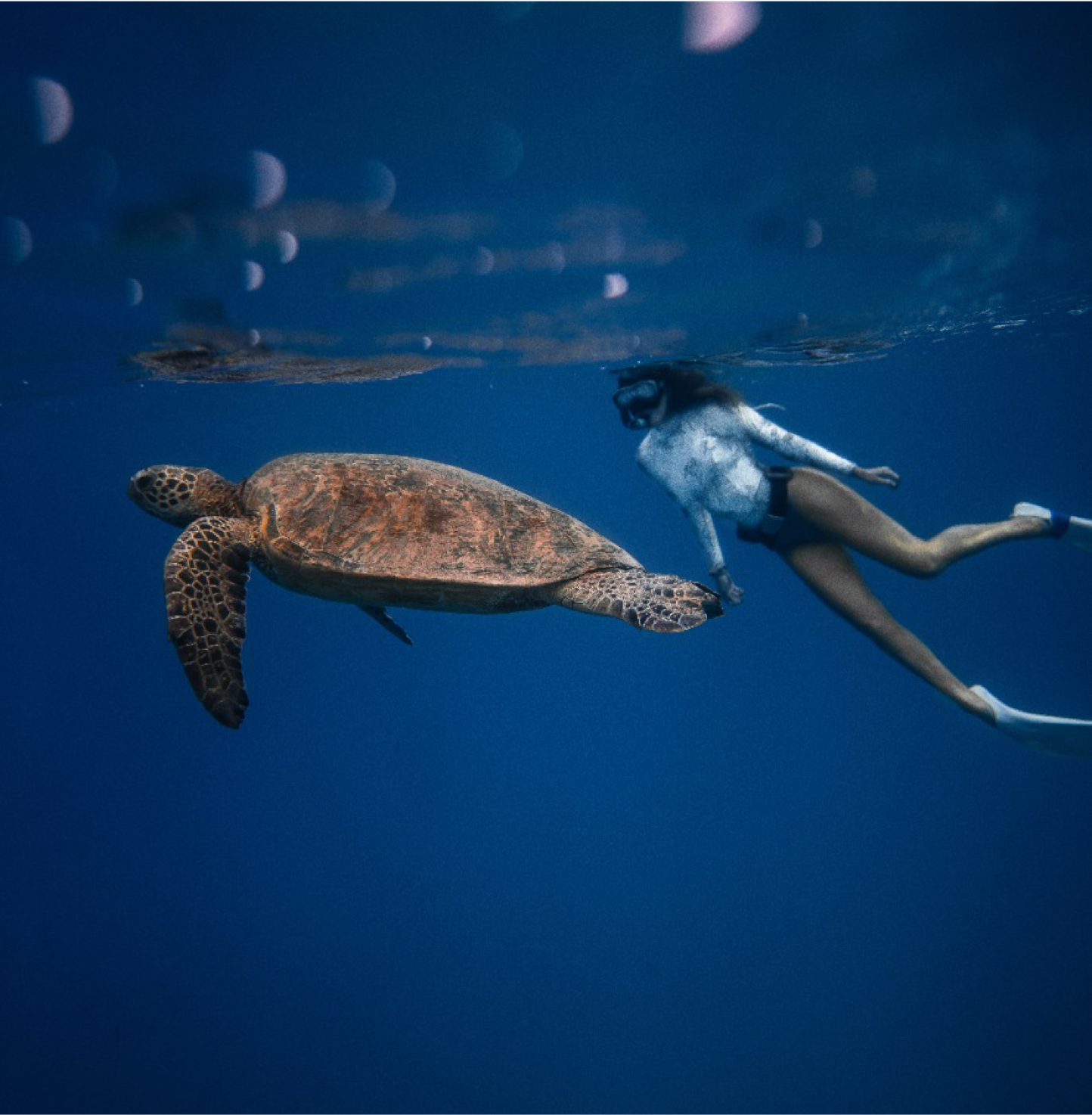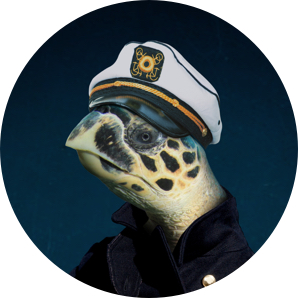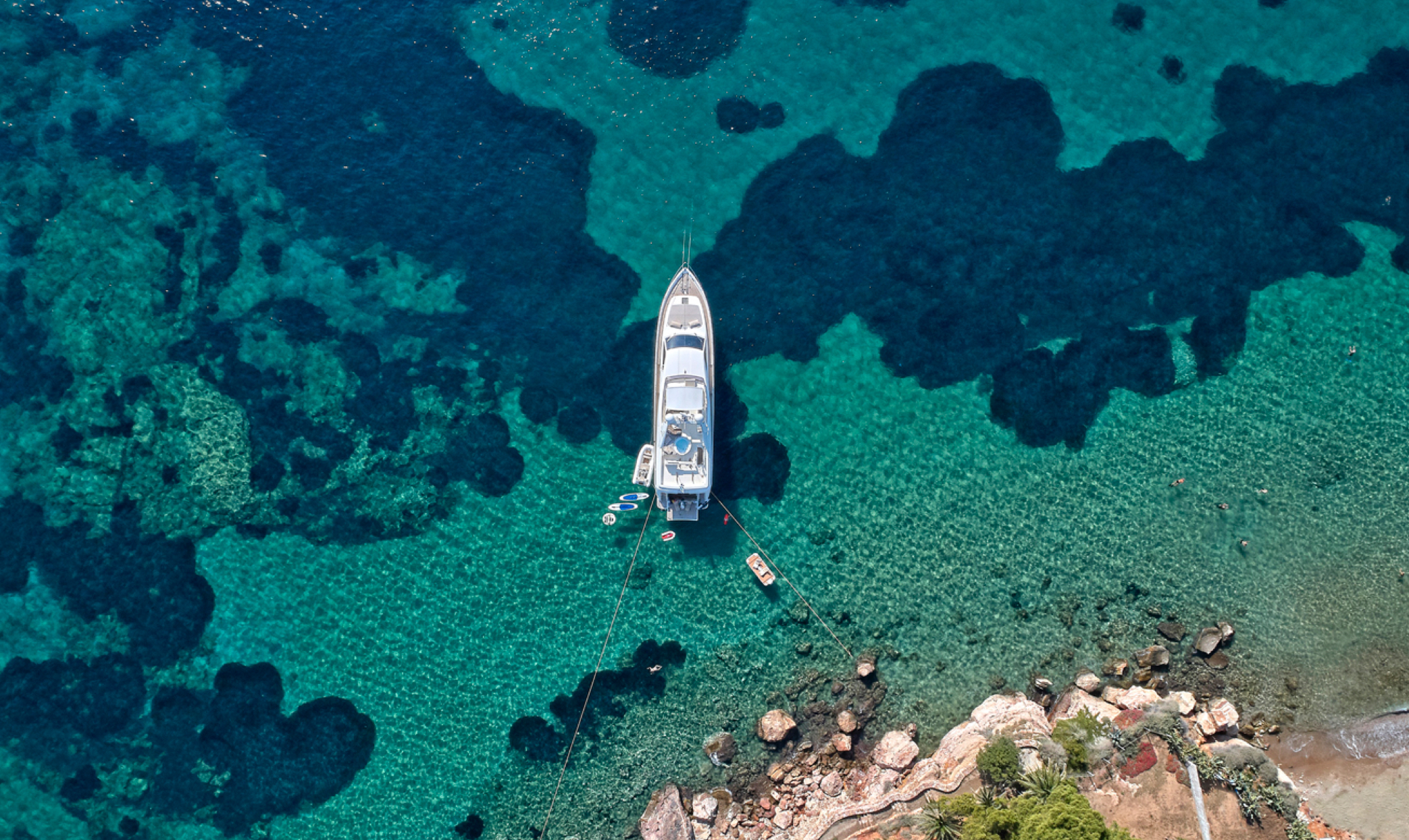
CAPTAIN PETROS' MAP TOSUSTAINABLEYACHTING
COME AND MEET OUR CAPTAIN!
With ancestors dating back to 100 million years, Captain Petros belongs to one of the world’s most legendary species: the loggerhead sea turtle Caretta caretta. Just like the rest of his family, Captain Petros comes ashore to bask in the warm sun or to nest and spends most of his life at sea. Sea turtles are our fellow voyagers in the Mediterranean; they have a strong, innate urge to travel, as well as an inexhaustible will to return home, albeit for a brief moment before venturing again into the unknown. For a very large population of turtles, the Greek coast is their chosen home; they return year after year, to start off a new life cycle.
However, in the last 200 years, humans have engaged into practices that disrupt the turtles’ natural marine environment. Captain Petros knows the challenges that can arise underwater and provides useful advice to yachtsmen who share their marine home.

AT EKKA YACHTS,
we are committed to raising awareness on environmental issues and provide alternatives for eco-friendly yachting. Collaborating closely with conservation organisations and consulting them, ensures that we are always up to date. To this end, we support ARCHELON, a protection society dedicated to preserving sea turtles in Greece.
We trust that Captain Petros is the best representative to guide you towards eco-conscious yachting!
EKKA TEAM



ANCHORING
Sustainable yachting involves not only your sailing habits, but your anchoring practices too. To avoid the risk of disrupting the - emblematic to the Mediterranean- seagrass (Posidonia oceanica), you need to be mindful of where you anchor. It is advised to anchor in designated areas, collective mooring fields or clear sandy areas. This will help avoid further destruction of Posidonia beds, one third of which has already been lost due to human malpractice across the Mediterranean.

CHEMICAL POLLUTANTS
Taking care of your yacht and living onboard may also have an impact on marine life due to the use of chemicals. Many products that contain chlorine, ammonia, phosphates, potassium hydroxide and solvents damage aquatic life or create nutrient imbalances leading to algal blooms, which in turn are harmful to aquatic environments.
What can we do?
- Choose environmentally friendly cleaners and detergents.
- Rinse yachts regularly with fresh water.
- Apply boat wax every year to avoid accumulation of contaminants.
- Avoid sunscreens which contain harmful chemical ingredients (oxybenzon, octinoxate).

NOISE POLLUTION
Have you heard? Noise pollution goes unnoticed because its effects are not visible. It, however, can be disturbing to some marine life, especially to species that communicate underwater. Noise control for yachts is feasible by using various techniques, such as modifying propellers, conducting regular maintenance, using vibration-isolating machinery, and being cautious when sailing into marine protected areas*, such as the Mediterranean Sea and the wider Caribbean region.

BIOFOULING
Yacht hulls accumulate microorganisms, plants and algae, a process known as biofouling. Chemical coatings of ships and boats’ underbellies, also known as antifouling paint, are applied to control or prevent the attachment of unwanted marine organisms onto the hull. Most antifouling coatings leak chemicals into the water over time and cause unwanted harm to marine life. To avoid this, one can apply a non-toxic coating as well as yacht wrapping, which can be incorporated on the hull. Also, new antifouling methods employ the use of ultrasonic waves, enzymes or silicone liquids, which protect both the yacht and the environment.

PLASTICS & SYNTHETIC WASTE DISPOSAL
Almost 200.000 micro-plastics per km2 float the Greek seas, a number that is expected to rise, while most islands and remote areas don’t have waste management infrastructure. It is understandably important to minimize waste.
How can it be done? Avoid single-use plastics, food packaging and plastic bags. Install a counter-top water dispenser and refill your personal drinking water bottle. Use refillable shampoo and soap bottles. Be informed before travelling as to which holiday spots offer recycling services. (e.g. Santorini, Syros, Lipsoi, Alonissos).

FOOD & ORGANIC WASTE DISPOSAL
Does organic waste have an impact on sea pollution? While food and organic waste is non-toxic and degrades in the sea, a rise in navigation creates problems of scale, because the marine environment cannot absorb large quantities of said waste. Similarly, if it’s dumped close to the shore, it also causes pollution. One thing you can do is to grind organic waste to smaller parts before disposing of it. Food waste must be ground to 25mm pieces or smaller before disposal. This waste can be discharged, as long as your yacht is at least 3 nautical miles away from the shore or 12 nautical miles, if you are in a special area*.

YEAR ROUND SUSTAINABILITY
There are many things that can be done in order to protect the precious marine environment even on days when you are not on board. An example is to support organizations such as ARCHELON, MOM, WWF, THALASSA FOUNDATION, CYCLADES PRESERVATION FUND, IONIAN ENVIRONMENT, MEDASSET, ENALEIA, BLUE CYCLE.

THE DISCHARGE PROVISIONS OF THE REVISED MARPOL ANNEX V WHICH ENTERED INTO FORCE ON 1 MARCH 2018
| GARBAGE TYPE | |
|---|---|
| ALL SHIPS EXCEPT PLATFORMS | |
| REGULATION 4OUTSIDE SPECIAL AREAS AND ARCTIC WATERS(Distances are from the nearest land) | REGULATION 6WITHIN SPECIAL AREAS AND ARCTIC WATERS(Distances are from nearest land, nearest ice-shelf or nearest fast ice) |
| FOOD WASTE COMMINUTED OR GROUND | |
| ≥3 NM, EN ROUTE AND AS FAR AS PRACTICABLE | ≥12 NM, EN ROUTE AND AS FAR AS PRACTICABLE |
| FOOD WASTE NOT COMMINUTED OR GROUND | |
| ≥12 NM, EN ROUTE AND AS FAR AS PRACTICABLE | DISCHARGE PROHIBITED |
| CLEANING AGENTS AND ADDITIVES CONTAINED IN CARGO HOLD WASHWATER | |
| DISCHARGE PERMITTED | ≥12 NM, EN ROUTE AND AS FAR AS PRACTICABLE(subject to conditions in regulation 6.1.2 and paragraph 5.2.1.5 of part II-A of tde Polar Code)DISCHARGE PERMITTED |
| CLEANING AGENTS AND ADDITIVES CONTAINED IN CARGO HOLD WASHWATER | |
| DISCHARGE PERMITTED | ≥12 NM, EN ROUTE AND AS FAR AS PRACTICABLE(subject to conditions in regulation 6.1.2 and paragraph 5.2.1.5 of part II-A of tde Polar Code)DISCHARGE PERMITTED |
| ALL OTHER GARBAGEincluding plastics, syntdetic ropes, fishing gear, plastic garbage bags, incinerator ashes, clinkers, cooking oil, floating dunnage, lining and packing materials, paper, rags, glass, metal, bottles, crockery and similar refuse | |
| DISCHARGE PROHIBITED | DISCHARGE PROHIBITED |
| GARBAGE TYPE | ALL SHIPS EXCEPT PLATFORMS | |
|---|---|---|
| REGULATION 4OUTSIDE SPECIAL AREAS AND ARCTIC WATERS(Distances are from the nearest land) | REGULATION 6WITHIN SPECIAL AREAS AND ARCTIC WATERS(Distances are from nearest land, nearest ice-shelf or nearest fast ice) | |
| FOOD WASTE COMMINUTED OR GROUND | ≥3 NM, EN ROUTE AND AS FAR AS PRACTICABLE | ≥12 NM, EN ROUTE AND AS FAR AS PRACTICABLE |
| FOOD WASTE NOT COMMINUTED OR GROUND | ≥12 NM, EN ROUTE AND AS FAR AS PRACTICABLE | DISCHARGE PROHIBITED |
| CLEANING AGENTS AND ADDITIVES CONTAINED IN CARGO HOLD WASHWATER | DISCHARGE PERMITTED | ≥12 NM, EN ROUTE AND AS FAR AS PRACTICABLE(subject to conditions in regulation 6.1.2 and paragraph 5.2.1.5 of part II-A of the Polar Code)DISCHARGE PERMITTED |
| CLEANING AGENTS AND ADDITIVES IN DECK AND EXTERNAL SURFACES WASHWATER | ||
| ALL OTHER GARBAGEincluding plastics, synthetic ropes, fishing gear, plastic garbage bags, incinerator ashes, clinkers, cooking oil, floating dunnage, lining and packing materials, paper, rags, glass, metal, bottles, crockery and similar refuse | DISCHARGE PROHIBITED | DISCHARGE PROHIBITED |
- When garbage is mixed with or contaminated by other harmful substances prohibited from discharge or having different discharge requirements, the more stringent requirements shall apply.
- Comminuted or ground food wastes must be able to pass through a screen with mesh no larger than 25 mm.
- The discharge of introduced avian products in the Antarctic area is not permitted unless incinerated, autoclaved or otherwise treated to be made sterile. In polar waters, discharge shall be made as far as practicable from areas of ice concentration exceeding 1/10; in any case food wastes shall not be discharged onto the ice.
- These substances must not be harmful to the marine environment.

TOWARDS A MORE SUSTAINABLE YACHTING INDUSTRY
Protecting marine life and assuming responsible yachting practices is a mission that is gathering momentum in the yachting industry. A number of steps are being taken towards its fulfillment:



*The special areas established under MARPOL (The International Convention for the Prevention of Pollution from Ships) are:
- the Mediterranean Sea
- the Baltic Sea
- the Black Sea
- the Red Sea
- the Gulfs area
- the North Sea
- the Wider Caribbean Region and
- Antarctic Area